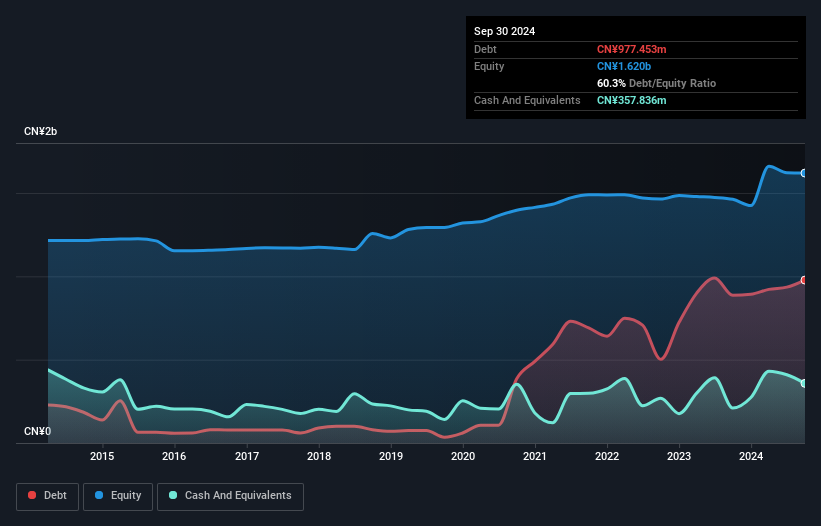Would Sichuan Crun (SZSE:002272) Be Better Off With Less Debt?
Would Sichuan Crun (SZSE:002272) Be Better Off With Less Debt?
Some say volatility, rather than debt, is the best way to think about risk as an investor, but Warren Buffett famously said that 'Volatility is far from synonymous with risk.' So it seems the smart money knows that debt - which is usually involved in bankruptcies - is a very important factor, when you assess how risky a company is. Importantly, Sichuan Crun Co., Ltd (SZSE:002272) does carry debt. But the real question is whether this debt is making the company risky.
有些人认为,与债务相比,波动性是投资者考虑风险的最好方式,但沃伦·巴菲特曾著名地说过:‘波动性远非等同于风险。’ 所以,聪明的钱似乎知道,债务——这通常与破产有关——是在评估一家公司风险时一个非常重要的因素。重要的是,川润股份有限公司(SZSE:002272)确实承担债务。但是,真正的问题是,这些债务是否让公司变得风险更大。
Why Does Debt Bring Risk?
为什么债务带来风险?
Debt assists a business until the business has trouble paying it off, either with new capital or with free cash flow. Part and parcel of capitalism is the process of 'creative destruction' where failed businesses are mercilessly liquidated by their bankers. While that is not too common, we often do see indebted companies permanently diluting shareholders because lenders force them to raise capital at a distressed price. By replacing dilution, though, debt can be an extremely good tool for businesses that need capital to invest in growth at high rates of return. The first step when considering a company's debt levels is to consider its cash and debt together.
债务在企业中起辅助作用,直到企业在用新资本或自由现金流还债方面遇到麻烦。资本主义的一部分过程是‘创造性毁灭’,在这个过程中,失败的企业会被他们的银行家无情清算。虽然这种情况并不太常见,但我们确实经常看到负债公司因贷款方强迫他们以低价筹集资本而永久性稀释股东。通过替代稀释,债务可以成为那些需要资本以高回报率投资于增长的企业的极好工具。考虑到公司的债务水平时,第一步是将其现金和债务放在一起考虑。
What Is Sichuan Crun's Debt?
川润的债务是多少?
You can click the graphic below for the historical numbers, but it shows that as of September 2024 Sichuan Crun had CN¥977.5m of debt, an increase on CN¥886.1m, over one year. On the flip side, it has CN¥357.8m in cash leading to net debt of about CN¥619.6m.
您可以点击下面的图形查看历史数据,但它显示截至2024年9月,川润的债务为人民币97750万元,比一年前的人民币88610万元有所增加。另一方面,它有人民币35780万元的现金,导致净债务约为人民币61960万元。

A Look At Sichuan Crun's Liabilities
四川川润的负债分析
According to the last reported balance sheet, Sichuan Crun had liabilities of CN¥1.38b due within 12 months, and liabilities of CN¥556.1m due beyond 12 months. Offsetting these obligations, it had cash of CN¥357.8m as well as receivables valued at CN¥1.38b due within 12 months. So it has liabilities totalling CN¥199.2m more than its cash and near-term receivables, combined.
根据最新的资产负债表,川润股份的负债为13.8亿人民币,需在12个月内偿还,55610万元的负债需在12个月后偿还。为抵消这些负债,它有35780万元的现金以及价值138亿元、需在12个月内偿还的应收账款。因此,它的负债总额比其现金和短期应收账款总和多出19920万元。
Since publicly traded Sichuan Crun shares are worth a total of CN¥3.99b, it seems unlikely that this level of liabilities would be a major threat. However, we do think it is worth keeping an eye on its balance sheet strength, as it may change over time. The balance sheet is clearly the area to focus on when you are analysing debt. But it is Sichuan Crun's earnings that will influence how the balance sheet holds up in the future. So if you're keen to discover more about its earnings, it might be worth checking out this graph of its long term earnings trend.
由于川润股份的公允市值总计为39.9亿人民币,这种负债水平似乎不会构成重大威胁。然而,我们认为关注其资产负债表的实力是值得的,因为它可能会随时间变化。当您分析债务时,资产负债表显然是关注的重点。但影响资产负债表未来表现的是川润股份的收益。因此,如果您想了解更多关于其收益的信息,查看其长期收益趋势的图表可能是值得的。
Over 12 months, Sichuan Crun made a loss at the EBIT level, and saw its revenue drop to CN¥1.6b, which is a fall of 12%. We would much prefer see growth.
在过去12个月内,川润股份在EBIT水平上出现了亏损,营业收入降至16亿元,下降幅度为12%。我们更希望看到增长。
Caveat Emptor
买者自负盈亏
Not only did Sichuan Crun's revenue slip over the last twelve months, but it also produced negative earnings before interest and tax (EBIT). Indeed, it lost CN¥40m at the EBIT level. Considering that alongside the liabilities mentioned above does not give us much confidence that company should be using so much debt. So we think its balance sheet is a little strained, though not beyond repair. Another cause for caution is that is bled CN¥105m in negative free cash flow over the last twelve months. So suffice it to say we do consider the stock to be risky. There's no doubt that we learn most about debt from the balance sheet. However, not all investment risk resides within the balance sheet - far from it. For example, we've discovered 4 warning signs for Sichuan Crun (3 don't sit too well with us!) that you should be aware of before investing here.
川润股份的营业收入不仅在过去12个月中下降,而且在利息和税前收益(EBIT)方面也出现了负收益。实际上,EBIT水平的亏损为4000万元。考虑到以上提到的负债,这让我们对公司使用如此多的债务信心不足。因此,我们认为其资产负债表有些紧张,但并非无可修复。另一个需要谨慎的原因是,在过去的12个月里,它的自由现金流出现了负10500万元。因此,可以说我们确实认为这只股票存在风险。毫无疑问,我们从资产负债表中学到了大部分关于债务的信息。然而,并非所有的投资风险都存在于资产负债表中,远非如此。例如,我们发现了川润股份的4个警告信号(其中3个让我们感到不安!),投资前您应该了解这些。
If you're interested in investing in businesses that can grow profits without the burden of debt, then check out this free list of growing businesses that have net cash on the balance sheet.
如果您有兴趣投资那些能够在没有债务负担的情况下增长利润的业务,请查看这个自由名单,其中列出了在资产负债表上有净现金的成长型企业。
Have feedback on this article? Concerned about the content? Get in touch with us directly. Alternatively, email editorial-team (at) simplywallst.com.
This article by Simply Wall St is general in nature. We provide commentary based on historical data and analyst forecasts only using an unbiased methodology and our articles are not intended to be financial advice. It does not constitute a recommendation to buy or sell any stock, and does not take account of your objectives, or your financial situation. We aim to bring you long-term focused analysis driven by fundamental data. Note that our analysis may not factor in the latest price-sensitive company announcements or qualitative material. Simply Wall St has no position in any stocks mentioned.
对本文有反馈?对内容有疑虑?请直接与我们联系。或者,发送电子邮件至 editorial-team (at) simplywallst.com。
这篇来自Simply Wall St的文章是一般性的。我们根据历史数据和分析师预测提供评论,采用无偏见的方法,我们的文章并不旨在提供财务建议。它不构成对任何股票的买入或卖出建议,也未考虑到您的目标或财务状况。我们旨在为您提供以基本数据驱动的长期分析。请注意,我们的分析可能未考虑最新的价格敏感公司公告或定性材料。Simply Wall St在提到的任何股票中均没有持仓。

 According to the last reported balance sheet, Sichuan Crun had liabilities of CN¥1.38b due within 12 months, and liabilities of CN¥556.1m due beyond 12 months. Offsetting these obligations, it had cash of CN¥357.8m as well as receivables valued at CN¥1.38b due within 12 months. So it has liabilities totalling CN¥199.2m more than its cash and near-term receivables, combined.
According to the last reported balance sheet, Sichuan Crun had liabilities of CN¥1.38b due within 12 months, and liabilities of CN¥556.1m due beyond 12 months. Offsetting these obligations, it had cash of CN¥357.8m as well as receivables valued at CN¥1.38b due within 12 months. So it has liabilities totalling CN¥199.2m more than its cash and near-term receivables, combined.